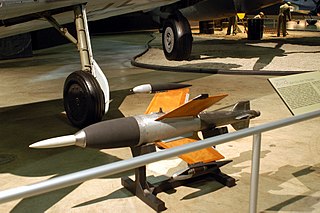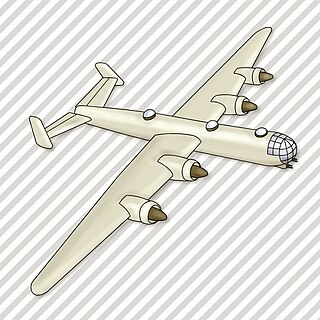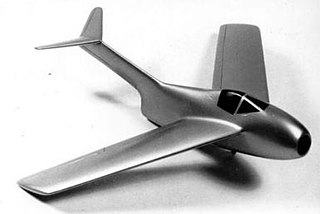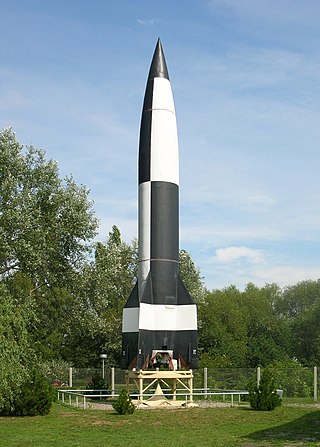History
The P.1108 was designed by Dr. Wurster, to a concept by Dr. Alexander Lippisch. It was to have four Heinkel HeS 011 jet engines placed in the wing near the trailing edge, with intakes under the leading edge and ducting through it. [2] Fully loaded weight was to be 30 tons, and range of 7,000 km (4,300 mi; 3,800 nmi) at a speed of 800–850 km/h (500–530 mph; 430–460 kn) and a height of 9,000–12,000 m (30,000–39,000 ft). [3] [4]
While not a true flying wing, it was tailless (with only a stabilizing fin and rudder).
While the Fedden Mission was told about the project, none of the information provided by Messerschmitt's employees could be independently verified, since all data had already been removed by the French. No aircraft were completed. [5]

The Messerschmitt Me 163 Komet is a rocket-powered interceptor aircraft primarily designed and produced by the German aircraft manufacturer Messerschmitt. It is the only operational rocket-powered fighter aircraft in history as well as the first piloted aircraft of any type to exceed 1,000 kilometres per hour (620 mph) in level flight.

The Messerschmitt Me 262, nicknamed Schwalbe in fighter versions, or Sturmvogel in fighter-bomber versions, is a fighter aircraft and fighter-bomber that was designed and produced by the German aircraft manufacturer Messerschmitt. It was the world's first operational jet-powered fighter aircraft.

The Enzian was a German WWII surface-to-air anti-aircraft missile that was the first to use a radio controlled guidance system. During the missile's development in the late stages of the war it was plagued by organisational problems and was cancelled before becoming operational.

The Heinkel He 162 Volksjäger was a German single-engine, jet-powered fighter aircraft fielded by the Luftwaffe in World War II. Developed under the Emergency Fighter Program, it was designed and built quickly and made primarily of wood as metals were in very short supply and prioritised for other aircraft. Volksjäger was the Reich Air Ministry's official name for the government design program competition won by the He 162 design. Other names given to the plane include Salamander, which was the codename of its wing-construction program, and Spatz ("Sparrow"), which was the name given to the plane by the Heinkel aviation firm.

The Ruhrstahl Ru 344 X-4 or Ruhrstahl-Kramer RK 344 was a wire-guided air-to-air missile designed by Germany during World War II. The X-4 did not see operational service and thus was not proven in combat but inspired considerable post-war work around the world, and was the basis for the development of several ground-launched anti-tank missiles, including the Malkara.

The BMW 003 is an early axial turbojet engine produced by BMW AG in Germany during World War II. The 003 and the Junkers Jumo 004 were the only German turbojet engines to reach production during World War II.

The Messerschmitt Me 263 Scholle (plaice) was a rocket-powered fighter aircraft developed from the Me 163 Komet towards the end of World War II. Three prototypes were built but never flown under their own power as the rapidly deteriorating military situation in Germany prevented the completion of the test program.

The Heinkel He 277 was a four-engine, long-range heavy bomber design, originating as a derivative of the He 177, intended for production and use by the German Luftwaffe during World War II. The main difference was in its engines. The He 177 used two Daimler-Benz DB 606 "power system" engines, each of which consisted of two combined Daimler-Benz DB 601 engines, each DB 606 weighed 1.5 tons. The He 177A-3 and its successors used two DB 610 "power system" engines, each of which consisted of two combined Daimler-Benz DB 605 engines, each DB 610 weighed 1.5 tons. Due to problems with both the DB 606 and the DB 610, the He 277 was intended to use four unitized BMW 801E 14-cylinder radial engines, each mounted in an individual nacelle and each turning a three-blade, four-meter diameter propeller.

Henschel's Hs 132 was a World War II dive bomber and interceptor aircraft of the German Luftwaffe that never saw service. The unorthodox design featured a top-mounted BMW 003 jet engine and the pilot in a prone position. The Soviet Army occupied the factory just as the Hs 132 V1 was nearing flight testing, the V2 and V3 being 80% and 75% completed.

The Focke-Wulf Ta 183 Huckebein was a design for a jet-powered fighter aircraft intended as the successor to the Messerschmitt Me 262 and other day fighters in Luftwaffe service during World War II. It had been developed only to the extent of wind tunnel models when the war ended, but the basic design was further developed postwar in Argentina as the FMA IAe 33 Pulqui II. The name Huckebein is a reference to a trouble-making raven from an illustrated story in 1867 by Wilhelm Busch.

The Emergency Fighter Program was the program that resulted from a decision taken on July 3, 1944 by the Luftwaffe regarding the German aircraft manufacturing companies during the last year of the Third Reich.

Wunderwaffe is German word meaning "wonder-weapon" and was a term assigned during World War II by Nazi Germany's propaganda ministry to some revolutionary "superweapons". Most of these weapons however remained prototypes, which either never reached the combat theater, or if they did, were too late or in too insignificant numbers to have a military effect.

The Messerschmitt P.1101 was a single-seat, single-jet fighter project of World War II, developed as part of the 15 July 1944 Emergency Fighter Program which sought a second generation of jet fighters for the Third Reich. A prominent feature of the P.1101 prototype was that the sweep angle of the wings could be changed before flight, a feature further developed in later variable-sweep aircraft such as the Bell X-5 and Grumman XF10F Jaguar.

The Messerschmitt P.1112 was a proposed German jet fighter, developed by Messerschmitt AG during the closing stages of World War II, and intended for use by the Luftwaffe. The progress of the war prevented the completion of a prototype before the fall of Nazi Germany. Its design, however, had a direct influence on postwar US Navy carrier fighters.

The Messerschmitt P.1110 was a design for a single-seat, high-altitude interceptor, prepared for the German Luftwaffe by the Messerschmitt aircraft manufacturing company, under the Emergency Fighter Program during the last months of World War II.
The Deutsche Luftfahrtforschungsanstalt was a secret German facility for airframe, aeroengine, and aircraft weapons testing during the Second World War. It was Germany's "most advanced and extensive [aviation] research establishment, outside of the existing Erprobungsstelle network of military aviation evaluation facilities, themselves headquartered at Rechlin.
The BMW 109-718 was a liquid-fuelled rocket engine developed by BMW at their Bruckmühl facility, in Germany during the Second World War.
The Fedden Mission was a British scientific mission sent by the Ministry of Aircraft Production to Germany at the end of the Second World War in Europe, to gather technical intelligence about German aircraft and aeroengines. It was named for the Mission's leader, Roy Fedden. It visited Bad Oeynhausen, Bad Eilsen, Völkenrode, Braunschweig, Magdeburg, Oschersleben, Staßfurt, Dessau, Kothen, Nordhausen, Göttingen, Kassel, Eisenach, Frankfurt, Rüsselsheim, Darmstadt, Stuttgart, Esslingen, Reutlingen, Mengen, Lindau, Freising, Munich, Rosenheim, Kochel, Oberammergau, Kolbermoor, Salzburg, Spittal, Villach, and Klagenfurt. This is much less than the fifty-two locations they had intended to visit when the Mission began.
The Lippisch Delta VI was a proposed single-seat, twin-jet experimental delta flying wing aircraft begun in 1943 by German designer Alexander Lippisch, as the developed version of the P.11 bomber project begun while he was still working for Messerschmitt in 1942. The only prototype was destroyed in June 1944 while still under construction.














